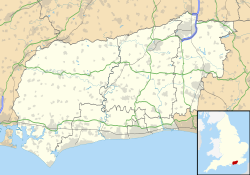Barkhale Camp
 Shown within West Sussex | |
| Location | near Bignor, West Sussex |
|---|---|
| Coordinates | 50°54′17″N 0°36′49″W / 50.90472°N 0.61361°WCoordinates: 50°54′17″N 0°36′49″W / 50.90472°N 0.61361°W |
| OS grid reference | SU 976 126 |
| Type | Causewayed enclosure |
| History | |
| Periods | Neolithic |
| Designated | 7 April 1967 |
| Reference no. | 1007880 |
Barkhale Camp is a Neolithic causewayed enclosure, an archaeological site on the South Downs in West Sussex, England. It is about 1 mile (1.6 km) south-west of the village of Bignor.
The site is a scheduled monument.[1] It is on the Slindon Estate, which is a National Trust property.[2][3]
Description[]
Causewayed enclosures are found mostly in southern and eastern England; they have an area of 1–28 hectares (2–69 acres), and were constructed in the middle part of the Neolithic period, about 3000–2400 BC.[1]
Barkhale Camp is on a gentle south-facing slope of Bignor Hill. It is an oval enclosure, 220 metres (720 ft) north to south and 150 metres (490 ft) west to east, defined by a bank of width 10 metres (33 ft) and height up to 0.5 metres (1 ft 8 in). There is an external ditch, up to 4 metres (13 ft) wide; it is in sections of length 10–30 metres (33–98 ft), with causeways between them. The area within the enclosure is about 3 hectares (7.4 acres).[1][4]
There were small-scale excavations in 1958–1961 by Veronica Seton-Williams, and in 1978 by the Sussex Archaeological Field Unit; pottery sherds and flint tools of the Neolithic period, and pottery sherds of later periods, were found.[1][4]
References[]
- ^ a b c d Historic England. "Barkhale Camp causewayed enclosure (1007880)". National Heritage List for England. Retrieved 22 November 2020.
- ^ "Barkhale Camp, Slindon Estate" National Trust. Retrieved 23 November 2020.
- ^ "Slindon Estate" National Trust. Retrieved 23 November 2020.
- ^ a b Historic England. "Barkhale Camp" PastScape. Retrieved 23 November 2020.
- Causewayed enclosures
- Scheduled Ancient Monuments in West Sussex
- National Trust properties in West Sussex
